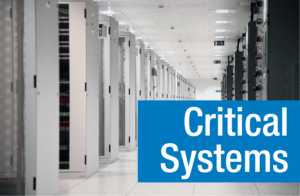
Even a basic containment system offers several immediate benefits beyond the energy savings. Hot spots will be reduced or eliminated, allowing for increased server life and reliability. Elimination of hot spots and recirculating air will also allow for higher power density and higher powered servers. There can even be an increase in the cooling capacity of the existing equipment as the difference in supply air and return air temperatures increase and the amount of air required for the space decreases.
Which should you choose: cold aisle and hot aisle?
Cold aisle
Implementation of cold aisle containment in your data center should take into account the supply air distribution method, server rack configuration, fire protection systems, and occupancy level within the data hall. A cold aisle containment system prevents supply air from bypassing the individual servers and the racks. This type of containment works best with up flow supply air delivery utilizing a raised floor plenum. The installation is simplified, and the overall system is the most cost effective when the cold aisles are uniform in size and the server inlets are facing each other on a given cold aisle.
One thing to keep in mind is that a cold aisle containment system can wreak havoc on the coverage area of the existing fire suppression system in the data hall. Before proceeding with the installation, you should contact your local code official to get their interpretation of the requirements in regards to fire suppression systems and cold aisle containment. A major drawback to cold aisle containment is that the remainder of the data hall that is not within the containment effectively becomes the hot aisle and will be subject to the elevated return temperatures. Customers that walk into the data hall immediately feel the higher temperature, which can cause concern, and employees working in the room for extended periods are exposed to the higher temperatures.
Hot aisle
Hot aisle containment is most effective with a drop ceiling serving as a return air plenum, but it will provide some benefit without a ceiling by separating the hot return air from the cool supply air. This separation increases the temperature of the return air to the mechanical equipment which results in increased capacity.
Depending on the configuration of the racks and the height between the top of the racks and the ceiling or structure, there are different hot aisle containment options. One is a ducted hot aisle system, similar to the cold aisle setup, is most cost effective when most of the server racks are configured in a hot aisle/cold aisle arrangement. In most cases legacy data center server racks are not completely configured in that arrangement, meaning the better option is to duct, or contain, the exhaust from individual racks or groups of rack using plastic or some other code compliant material to the ceiling plenum or up to the structure above. Containment of individual racks allows you to increase your amount of containment as your IT load increases and you have available funding. When implementing hot aisle containment system, it is important to note any overhead cabling, lights or fire suppression that could be in the way of the containment system.
Implementing a containment strategy can be a good way to realize some energy savings without disrupting the operations of your data center. It will also lead to more opportunities to efficiency improvements in other areas such as increasing supply air temperature set points or increasing chilled water delta T and supply temperatures. Start with identifying the existing conditions that could pose problems and then select the most appropriate containment system based on your constraints, budget, and objectives.
Have questions for our experts? Leave your comments below and visit our website for more information.






